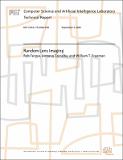| dc.description.abstract | We call a random lens one for which the function relating the input light ray to the output sensor location is pseudo-random. Imaging systems with random lensescan expand the space of possible camera designs, allowing new trade-offs in optical design and potentially adding new imaging capabilities. Machine learningmethods are critical for both camera calibration and image reconstruction from the sensor data. We develop the theory and compare two different methods for calibration and reconstruction: an MAP approach, and basis pursuit from compressive sensing. We show proof-of-concept experimental results from a random lens made from a multi-faceted mirror, showing successful calibration and image reconstruction. We illustrate the potential for super-resolution and 3D imaging. | |
